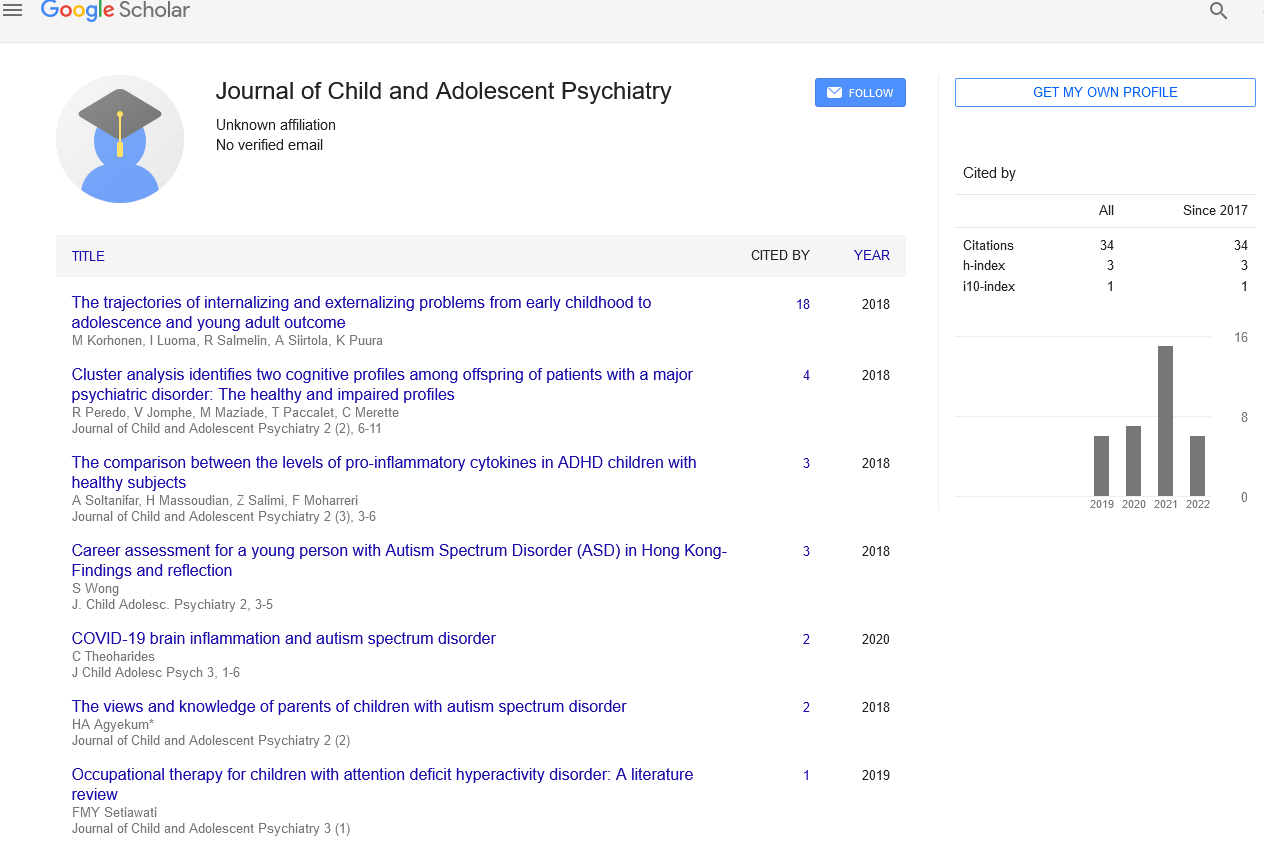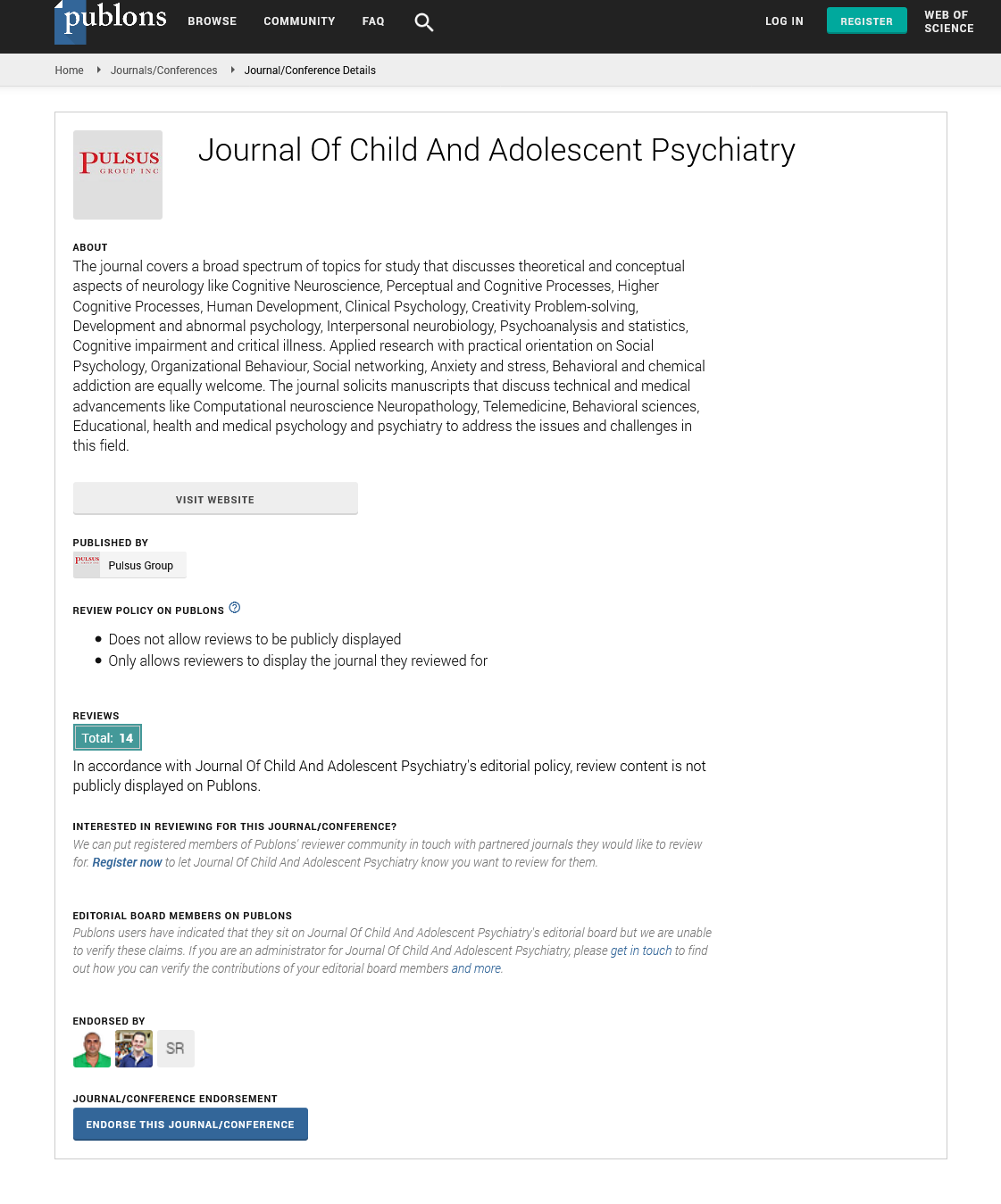The use of masturbation as a method of relieving migraine headaches in an adolescent with an eating disorder
Received: 12-Dec-2017 Accepted Date: Jan 29, 2018; Published: 08-Feb-2018
Citation: Appiah EK, Boachie A, Gasior S, et al. The use of masturbation as a method of relieving migraine headaches in an adolescent with an eating disorder. J Child Adolesc Psych. 2018;2(1):1-2.
This open-access article is distributed under the terms of the Creative Commons Attribution Non-Commercial License (CC BY-NC) (http://creativecommons.org/licenses/by-nc/4.0/), which permits reuse, distribution and reproduction of the article, provided that the original work is properly cited and the reuse is restricted to noncommercial purposes. For commercial reuse, contact reprints@pulsus.com
Abstract
This case report describes one case of an adolescent with an eating disorder and migraine headaches who reported masturbation as a relieving factor for her migraines. Sexual history poses as a challenging topic for adolescents overall. A therapeutic relationship and non-judgmental approach are important in gathering a thorough history to maximize care. It is imperative to ensure an appropriate sexual history is obtained and then re-evaluated when care management appears ineffective. Patients are more likely to offer more information when therapeutic, trusting and non-judgmental relationships are established.
Keywords
Masturbation; Migraine headache; Adolescent; Pharmacological
Introduction
Headaches often have a debilitating and pervasive an impact on an individual’s activities of daily living [1,2]. In adolescents, headaches affect up to 28% ages of 12-19 [3]. Migraines, are the most common cause of severe recurrent headaches among the pediatric population, affecting one in nine between the ages of five to fifteen [4]. The rate of new cases of individuals diagnosed with an eating disorder has been steadily increasing since 1950 [5]. The largest rise in incidence of anorexia nervosa is occurring in young women aged 15-19 [6], and the incidence of bulimia nervosa in women aged 10-39 years old has tripled between 1988 and 1993 [6]. There is an obvious overlap between the populations with eating disorders and those with migraine. This overlapping population provides challenges in the collection of an accurate history and the development of the therapeutic relationship.
Case Report
Among A 17-year-old female with an eating disorder was seen on several occasions for migraine headaches. The patient was observed to have increased purging behaviors along with reported migraine headaches. She reported her migraine trigger to be related to anxiety. Her headaches were described as intermittent, lasting approximately five to ten minutes and located around the temporal areas bilaterally. She stated that acetaminophen and ibuprofen were ineffective in the relief of her migraine headaches. Further discussions were held pertaining to the use of non-pharmacological methods for relief of her headaches such as reading a book, dimming the lights, watching television, and listening to music. All non-pharmacological interventions discussed were dismissed as ineffective for her. She reported that her headaches were relieved by self-masturbation, and expressed that discussing masturbation was embarrassing and challenging for her. Healthcare providers involved in her care were successful in establishing a therapeutic relationship, enabling this patient to openly discuss her sexual behaviors. She described herself as a sexual person and stated that maintaining abstinence was worsening her headaches. When anticipating a headache, she masturbated to prevent the headache from occurring. Patient stated that when she is in a public environment, she becomes more anxious when getting a headache because she is unable to masturbate in public.
Discussion
In the literature, there is no information on relief of migraine headaches with masturbation within the adolescent population. Further, no research currently exists highlighting the correlation between masturbation and the relief of headaches within the adolescent eating disorder population. Current research on this subject matter has predominantly focused on adult populations and has found that a correlation exists between masturbation, orgasm, and migraine headaches, warranting further research in other populations. Given the debilitating nature and prevalence of headaches in the adolescent population and the increasing rates of eating disordered youth, more research within this demographic is crucial.
Sexual activity and masturbation have been found to interact with headaches in different ways [7]. Research has aimed to identify the physiological mechanisms that contribute to the correlation between masturbation and/ or orgasm and the relief of migraines [7-9]. One explanation of the partial pain relief of migraines during sexual activity may be attributed to merely a distraction from the pain [7]. Other explanations have also been presented. According to the “gate control theory of pain”, sexual activity is thought to activate inhibitory pain modulating circuits [8]. This theory lends itself to the survival value in not “giving-in” to pain. Related to this process is the possibility that endorphin excretion, which occurs after sexual arousal and orgasm, may reduce the pain of migraines [9]. In line with these findings, [10] presented the idea that sexual activity and/or masturbation release endorphins, the post-orgasmic and extra genital reactions, similar to changes in blood pressure, can cause general pain relief. In female patients, the physiologic reflex related to the birth process, initiated during stimulation of the posterior vagina could be another cause of pain relief in general [11]. Such reactions are thought to perhaps also reduce pain during migraines.
Other ideas regarding the correlation between sexual activity and the relief of migraines relate to the central impulse generator or oscillator, and a biological clock within the hypothalamus. Activation of the posterior hypothalamus has been found during migraine episodes, and research suggests that refractory patients respond to hypothalamic deep brain stimulation [12]. Orgasm is accompanied by intense hypothalamic activation [9]; thus, it can be postulated that orgasm may terminate headaches by modulating hypothalamic circuits in a manner similar to that which occurs in deep brain stimulation.
Implications for Practice
It is always crucial for clinicians to gather and assess a thorough history from patients in order to provide comprehensive care, including the right treatment modalities and making recommendations to patients and their families. Developing therapeutic relationships, as well as having a non judgmental approach, is fundamental in building working relationships with the adolescent population. Self-disclosing sexual history and behaviors can be challenging for adolescents. The efficacy of pharmacological and non-pharmacological treatments for migraine headaches differs among patients. Therefore, it is important for clinicians to explore the use of both pharmacological and non-pharmacological treatment modalities in a patientcentered context. Clinicians must revaluate recommended treatments when they appear ineffective and alternative methods should be considered.
As noted in the above case study, the discussion itself can be difficult for the patient; sexual education with this patient population requires a sensitive approach and a non-threatening environment. Sexual education needs to be provided on an ongoing basis for this patient population in order to identify gaps and maximize care.
REFERENCES
- Winner P. Pediatric headache. Curr Opin Neurol. 2008;21(3):316-22.
- Roth-Isigkeit A, Thyen U, Stoven H, et al. Pain among children and adolescents: Restrictions in daily living and triggering factors. Pediatrics. 2005;115(2):152-62.
- Brna P, Gordon K, Dooley J. Canadian adolescents with migraine: Impaired health-related quality of life. J Child Neurol. 2007;23(1):39-43.
- Abu-Arefeh I, Russell G. Prevalence of headache and migraine in school children. Brit Med J. 1994;309(6957): 765-9.
- Hudson, JI Hiripi E, Pope HG, et al. The prevalence and correlates of eating disorders in the national comorbidity survey replication. World Biol Psychiatry. 2007;61(3):348-58.
- Hoek HW, Van HD. Review of the prevalence and incidence of eating disorders. Int J Eat Disord. 2003;34(4):383-396.
- Hambach A, Evers S, Summ O, et al. The impact of sexual activity on idiopathic headaches: An observational study. Cephalalgia. 2013;33(6):384-9.
- Sluka KA, Walsh D (2003) Transcutaneous electrical nerve stimulation: Basic science mechanisms and clinical effectiveness. J Pain. 2003;4(3):109–21.
- Meston CM, Frohlich PF. The neurobiology of sexual function. Arch Gen Psychiatry. 2000;57(11):1012–30.
- Masters WH, Johnson VE & Reproductive Biology Research Foundation (U.S.). Human sexual response. Boston: Little, Brown and Company; 1966.
- Caba M, Komisaruk BR, Beyer C. (1998). Analgesic synergism between AP5 (an NMDA receptor antagonist) and vaginocervical stimulation in the rat. Pharmacol Biochem Behav. 1998;61(1):45-48.
- Leone M, May A, Franzini A, et al. Deep brain stimulation for intractable chronic cluster headache: proposals for patient selection. Cephalalgia. 2004;24(11):934-7.






